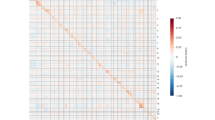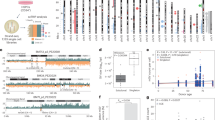Abstract
TET3 at 2p13.1 encodes tet methylcytosine dioxygenase 3, a demethylation enzyme that converts 5-methylcytosine to 5-hydroxymethylcytosine. Beck et al. reported that patients with TET3 abnormalities in either an autosomal dominant or recessive inheritance fashion clinically showed global developmental delay, intellectual disability, and dysmorphisms. In this study, exome sequencing identified both mono- and biallelic TET3 variants in two families: a de novo variant NM_001287491.1:c.3028 A > G:p.(Asn1010Asp), and compound heterozygous variants NM_001287491.1:c.[2077 C > T];[2896 T > G],p.[Gln693*];[Cys966Gly]. Despite the different inheritance modes, the affected individuals showed similar phenotypic features. Including these three patients, only 14 affected individuals have been reported to date. The accumulation of data regarding individuals with TET3-related disorder is necessary to describe their clinical spectrum.
This is a preview of subscription content, access via your institution
Access options
Subscribe to this journal
Receive 12 print issues and online access
$259.00 per year
only $21.58 per issue
Buy this article
- Purchase on Springer Link
- Instant access to full article PDF
Prices may be subject to local taxes which are calculated during checkout



Similar content being viewed by others
References
Wu X, Zhang Y. TET-mediated active DNA demethylation: mechanism, function and beyond. Nat Rev Genet. 2017;18:517–34.
Leturcq M, Lefebvre T, Vercoutter-Edouart AS. O-GlcNAcylation and chromatin remodeling in mammals: An up-to-date overview. Biochem Soc Trans. 2017;45:323–38.
Konzman D, Abramowitz LK, Steenackers A, Mukherjee MM, Na HJ, Hanover JA. O-GlcNAc: regulator of signaling and epigenetics linked to X-linked intellectual disability. Front Genet. 2020;11:1–19.
Kizuka Y, Kitazume S, Okahara K, Villagra A, Sotomayor EM, Taniguchi N. Epigenetic regulation of a brain-specific glycosyltransferase N-acetylglucosaminyltransferase-IX (GnT-IX) by specific chromatin modifiers. J Biol Chem. 2014;289:11253–61.
Deplus R, Delatte B, Schwinn MK, Defrance M, Méndez J, Murphy N, et al. TET2 and TET3 regulate GlcNAcylation and H3K4 methylation through OGT and SET1/COMPASS. EMBO J. 2013;32:645–55.
Shilatifard A. The COMPASS family of histone H3K4 methylases: mechanisms of regulation in development and disease pathogenesis. Annu Rev Biochem. 2012;81:65–95.
Szwagierczak A, Bultmann S, Schmidt CS, Spada F, Leonhardt H. Sensitive enzymatic quantification of 5-hydroxymethylcytosine in genomic DNA. Nucleic Acids Res 2010; 38. https://doi.org/10.1093/nar/gkq684.
Santiago M, Antunes C, Guedes M, Iacovino M, Kyba M, Reik W, et al. Tet3 regulates cellular identity and DNA methylation in neural progenitor cells. Cell Mol Life Sci. 2019;77:2871–83.
Gu TP, Guo F, Yang H, Wu HP, Xu GF, Liu W, et al. The role of Tet3 DNA dioxygenase in epigenetic reprogramming by oocytes. Nature. 2011;477:606–12.
Inoue A, Shen L, Matoba S, Zhang Y. Haploinsufficiency, but not defective paternal 5mC oxidation, accounts for the developmental defects of maternal Tet3 knockouts. Cell Rep. 2015;10:463–70.
Tsukada YI, Akiyama T, Nakayama KI. Maternal TET3 is dispensable for embryonic development but is required for neonatal growth. Sci Rep. 2015;5:1–13.
Beck DB, Petracovici A, He C, Moore HW, Louie RJ, Ansar M, et al. Delineation of a human mendelian disorder of the DNA demethylation machinery: TET3 deficiency. Am J Hum Genet. 2020;106:234–45.
Uchiyama Y, Yamaguchi D, Iwama K, Miyatake S, Hamanaka K, Tsuchida N, et al. Efficient detection of copy-number variations using exome data: Batch- and sex-based analyses. Hum Mutat. 2021;42:50–65.
Sakamoto M, Iwama K, Sekiguchi F, Mashimo H, Kumada S, Ishigaki K, et al. Novel EXOSC9 variants cause pontocerebellar hypoplasia type 1D with spinal motor neuronopathy and cerebellar atrophy. J Hum Genet. 2021;66:401–7.
Higasa K, Miyake N, Yoshimura J, Okamura K, Niihori T, Saitsu H, et al. Human genetic variation database, a reference database of genetic variations in the Japanese population. J Hum Genet. 2016;61:547–53.
Richards S, Aziz N, Bale S, Bick D, Das S, Gastier-Foster J, et al. Standards and guidelines for the interpretation of sequence variants: A joint consensus recommendation of the American College of Medical Genetics and Genomics and the Association for Molecular Pathology. Genet Med. 2015;17:405–24.
Guerois R, Nielsen JE, Serrano L. Predicting changes in the stability of proteins and protein complexes: a study of more than 1000 mutations. J Mol Biol. 2002;320:369–87.
Schymkowitz J, Borg J, Stricher F, Nys R, Rousseau F, Serrano L. The FoldX web server: an online force field. Nucleic Acids Res. 2005;33:382–8.
Hu L, Lu J, Cheng J, Rao Q, Li Z, Hou H, et al. Structural insight into substrate preference for TET-mediated oxidation. Nature. 2015;527:118–22.
Hu L, Li Z, Cheng J, Rao Q, Gong W, Liu M, et al. Crystal Structure of TET2-DNA Complex: Insight into TET-Mediated 5mC Oxidation. Cell. 2013;155:1545–55.
Maquat LE. Nonsense-mediated mRNA decay: Splicing, translation and mRNP dynamics. Nat Rev Mol Cell Biol. 2004;5:89–99.
Xu Y, Xu C, Kato A, Tempel W, Abreu JG, Bian C, et al. Tet3 CXXC domain and dioxygenase activity cooperatively regulate key genes for xenopus eye and neural development. Cell. 2012;151:1200–13.
Fang S, Li J, Xiao Y, Lee M, Guo L, Han W, et al. Tet inactivation disrupts YY1 binding and long-range chromatin interactions during embryonic heart development. Nat Commun. 2019;10:1–18.
Acknowledgements
We thank all patients and their families for their participation in this study. We would like to thank N. Watanabe, T. Miyama, M. Sato, S. Sugimoto, and K. Takabe for their technical assistance. We thank Catherine Perfect, MA (Cantab), from Edanz (https://jp.edanz.com/ac), for editing a draft of this manuscript. R. Seyama, N. Tsuchida, Y. Uchiyama and N. Matsumoto contributed to the study design. R. Seyama, N. Tsuchida, K. Hamada, K. Ogata, Y. Uchiyama and N. Matsumoto performed the data analysis. Y. Okada, S. Sakata, S. Okada and N. Okamoto evaluated clinical information of patients. R. Seyama, Y. Uchiyama and N. Matsumoto prepared the manuscript. N. Matsumoto finalized the manuscript. All authors critically read the manuscript, corrected, and approved the final version of the manuscript.
Funding
This study was supported by the Japan Agency for Medical Research and Development (AMED) (grant numbers: JP21ek0109486, JP21ek0109549, JP21cm0106503, and JP21ek0109493); JSPS KAKENHI (grant numbers: JP20K07907, JP20K08164, JP21k15097, JP20K17428, JP21K07869, and JP20K16932); the Takeda Science Foundation; and the Ichiro Kanehara Foundation for the Promotion of Medical Science and Medical Care.
Author information
Authors and Affiliations
Corresponding author
Ethics declarations
Competing interests
The authors declare no competing interests.
Additional information
Publisher’s note Springer Nature remains neutral with regard to jurisdictional claims in published maps and institutional affiliations.
Supplementary information
Rights and permissions
About this article
Cite this article
Seyama, R., Tsuchida, N., Okada, Y. et al. Two families with TET3-related disorder showing neurodevelopmental delay with craniofacial dysmorphisms. J Hum Genet 67, 157–164 (2022). https://doi.org/10.1038/s10038-021-00986-y
Received:
Revised:
Accepted:
Published:
Issue Date:
DOI: https://doi.org/10.1038/s10038-021-00986-y
This article is cited by
-
Distal arthrogryposis in a girl arising from a novel TNNI2 variant inherited from paternal somatic mosaicism
Journal of Human Genetics (2023)
-
A novel NONO variant that causes developmental delay and cardiac phenotypes
Scientific Reports (2023)
-
A novel homozygous CHMP1A variant arising from segmental uniparental disomy causes pontocerebellar hypoplasia type 8
Journal of Human Genetics (2023)
-
Long-read sequencing revealing intragenic deletions in exome-negative spastic paraplegias
Journal of Human Genetics (2023)



